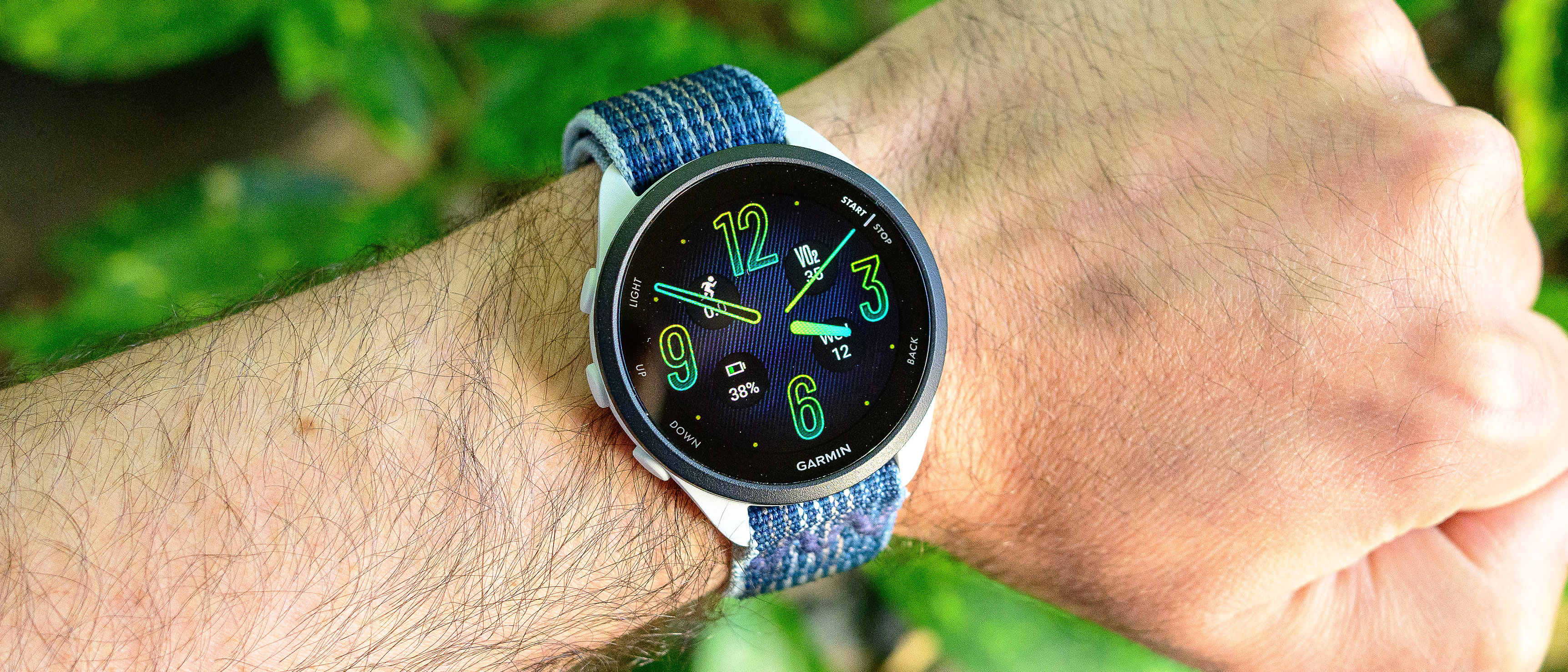Tom's Guide Verdict
The Garmin Forerunner 165 is a comfortable and lightweight GPS smartwatch sporting a bright AMOLED touchscreen, plenty of physical controls, solid battery life, accurate health sensors and advanced training and recovery tools borrowed from higher-end Garmin wearables.
Pros
- +
Lightweight and comfortable design
- +
Bright AMOLED touchscreen
- +
Accurate GPS and heart rate sensor
- +
Advanced training and recovery tools
- +
Good battery life
Cons
- -
GPS can be slow to connect
- -
Limited sport profiles compared to higher-end Garmins
- -
Not a ton of smart features
Why you can trust Tom's Guide
Price: $249.99 (Forerunner 165) and $299.99 (Forerunner 165 Music)
Display: 1.2-inch AMOLED
Heart rate monitor: Yes
SpO2 sensor: Yes
GPS: Yes
Battery life: 11 days (smartwatch mode), 19 hours (tracking mode with GPS)
Water resistance: 50 meters
Onboard music storage: Yes (Forerunner 165 Music)
Mobile payment: Yes
The Garmin Forerunner 165 is one of Garmin's most affordable GPS smartwatches equipped with an AMOLED touchscreen. It's also packed with health sensors and tools to help you monitor, train and recover from workouts, making it a great option for runners, joggers, hikers and even bikers.
Sitting between the entry-level Forerunner 55 and the more advanced Forerunner 265/265S, the Garmin Forerunner 165 boasts excellent battery life, sleep, stress and menstrual health tracking, reliable GPS and wellness monitoring and an overall comfortable and handsome design.
Nearly identical in appearance to the smaller 265S — here's a detailed comparison of the Forerunner 165 vs. 265 — the former omits dual-band GPS to keep the price down. There are, of course, other differences, like support for fewer sports profiles than its big brother.
In addition to fitness and health features, the Forerunner 165 also offers a smattering of smart ones, including tap-to-pay, mirrored smartphone notifications, music control and Garmin's handy LiveTrack safety feature.
I've had the chance to test out the Garmin Forerunner 165 over two months while walking, hiking, biking, sleeping and swimming to get a complete understanding of its capabilities, quirks and overall competence, how it compares to the best sports watches, and where it ranks among the best Garmin watches.
Garmin Forerunner 165: price and availability
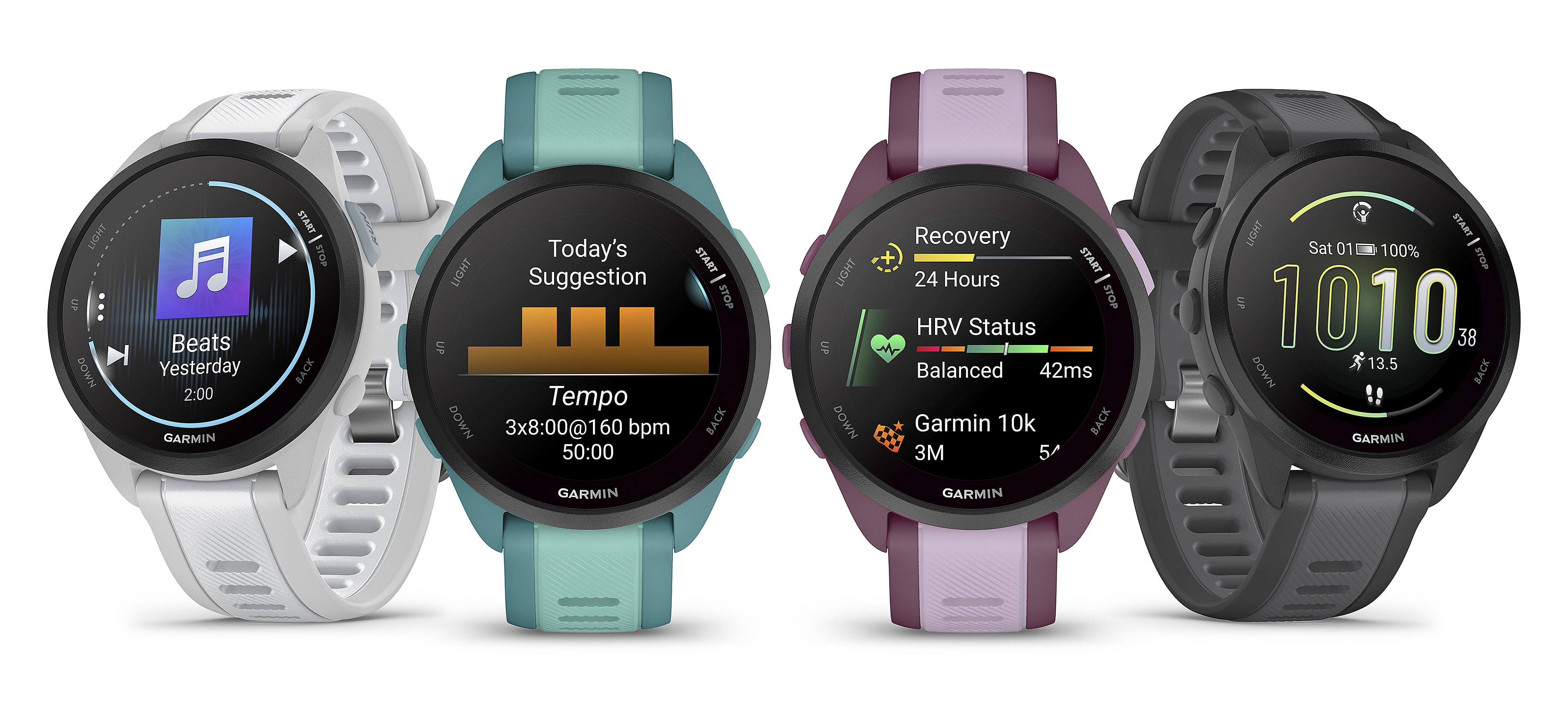
The Garmin Forerunner 165 and Forerunner 165 Music are available now for $249.99 and $299.99, respectively. It comes in four styles, shown above, including mist grey/whitestone, turquoise/aqua, berry/lilac and black/slate grey.
Both versions boast 11 days of battery life in smartwatch mode and 19 hours in tracking mode with the onboard GPS running. The latter comes with 4GB of onboard storage for music, which you can download via apps including Spotify, Amazon Music, Deezer and Youtube Music (as of June 2024).
If you enjoy running/working out without a bulky phone in your pocket — like me — the $50 upgrade may be worth it.
Garmin Forerunner 165 review: design
The Forerunner 165 shares a lot with the Garmin Vivoactive 5, including the same 1.2-inch display, battery life and case size. It also resembles its big bro, the Forerunner 265, which comes in two variants: the 265S with a 1.1-inch screen and the standard Forerunner 265 with a 1.3-inch display; the Garmin 165's screen notably splits the difference.
The Forerunner series is geared more toward hardcore fitness folks than the Vivoactive line, with an emphasis on tools to help train for goals, including races and milestones. And the Forerunner 165 is no exception. On the other hand, the Vivoactive line is more for casual health-conscious users, with a greater focus on general fitness and well-being.
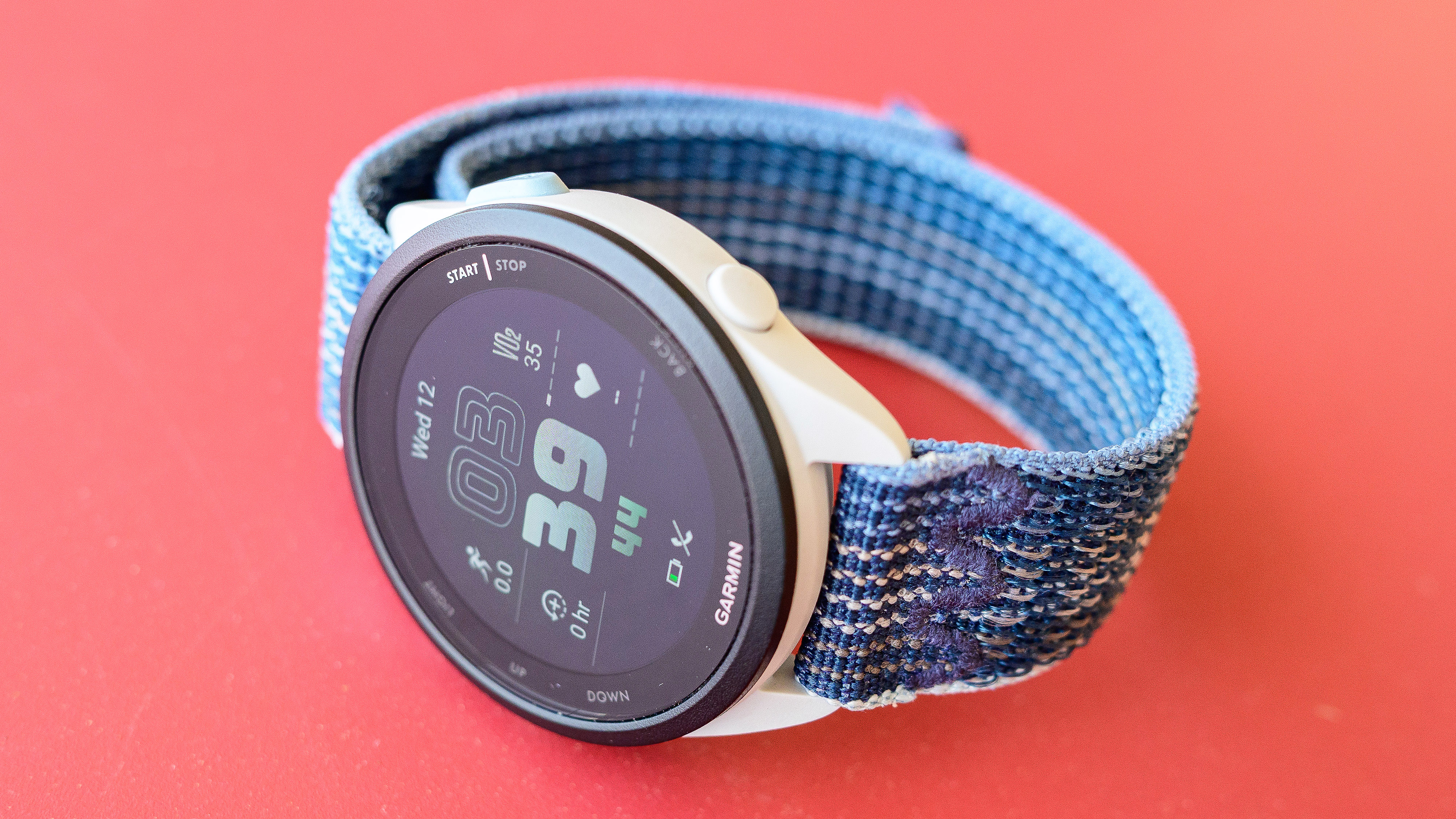
Construction-wise, the Vivoactive case is aluminum, while the Forerunner 165 sports a polymer case and bezel. As noted, both devices utilize the same lovely 1.2-inch AMOLED touchscreen with bold, bright colors for easy viewing in direct sunlight.
On my 7.5-inch wrist, the Forerunner 165 wears comfortably. With a case diameter of 42mm, it also doesn't look oversized, even if I tend to prefer 38-40mm watches.
Additionally, the Forerunner 165 offers a tried-and-true five-button interface compared to the Vivoactive's two buttons. As someone who sweats a lot when I work out, tactile buttons are definitely more reliable than touchscreens. The interface took a couple of days to get used to but now operating the watch is like second nature.
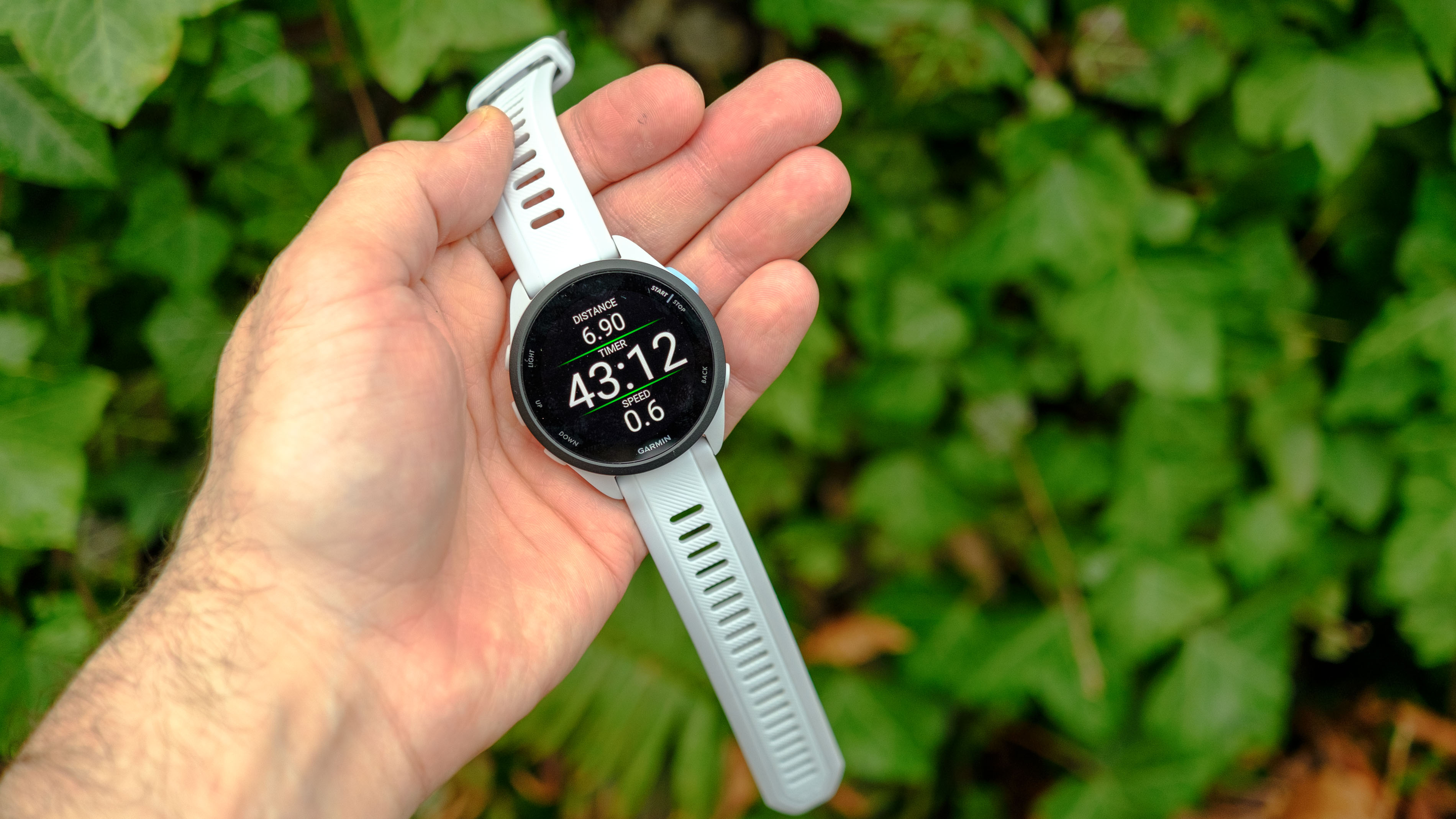
On the wrist, the Forerunner 165 feels light but well-built. You get 50 meters of water resistance, which is more than enough to survive time spent on an ultra-sweaty wrist, in rainstorms or submerged in wet stuff during shallow swims. No deep dives, though.
It's a pleasure to see Garmin use standard 20mm spring bars for attaching the band. The included strap is a soft, lightweight silicone affair that closes with a plastic pin and buckle system.
Don't like that include band? Feel free to swap in any other 20mm strap of your choosing. The included spring bars even have quick releases, so you don’t need a tool to make the change. I ended up tossing on a cheap woven band I picked up for around $10 on Amazon and love it.
By the way, having just come off testing the comparatively chonky Polar V3 smartwatch, the Forerunner 165 feels like next to nothing on the wrist.
Garmin Forerunner 165 review: GPS accuracy
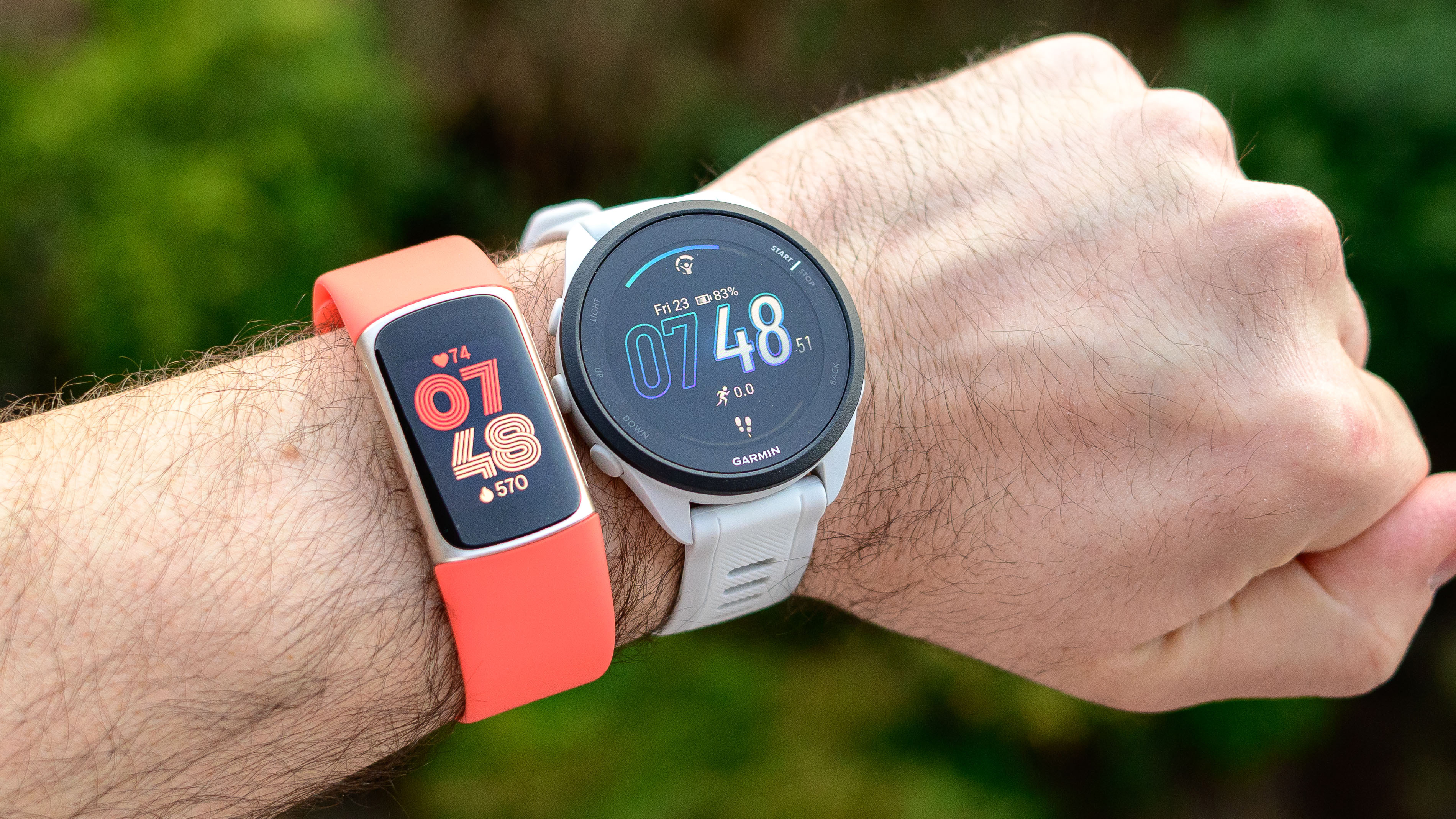
On my first outing with the Forerunner 165, I tested the onboard GPS during a roughly 10-mile bike ride to see how its distance tracking compares to Strava on my smartphone.
More specifically, I ran this test biking around the most densely populated areas of Seattle, WA, where large buildings and old-growth conifers often block views of the sky.
The Forerunner took about 45 seconds to connect to GPS at the start of my ride, which is a pretty long time compared to dual-band GPS watches. Nevertheless, it remained connected throughout.
Ultimately, the Garmin marked my ride as 9.54 miles in length with 577 feet of elevation gain. Strava pinned the same ride at 9.48 miles with 534 feet of elevation gain — that's pretty darn similar.
I further tested the Garmin Forerunner 165's GPS and step-count accuracy against the Apple Watch SE, Polar Grit X2 Pro and Fitbit Charge 6 and found it beats and/or competes with many of the best fitness trackers available right now when it comes to distance and location accuracy.
Garmin Forerunner 165 review: sports profiles
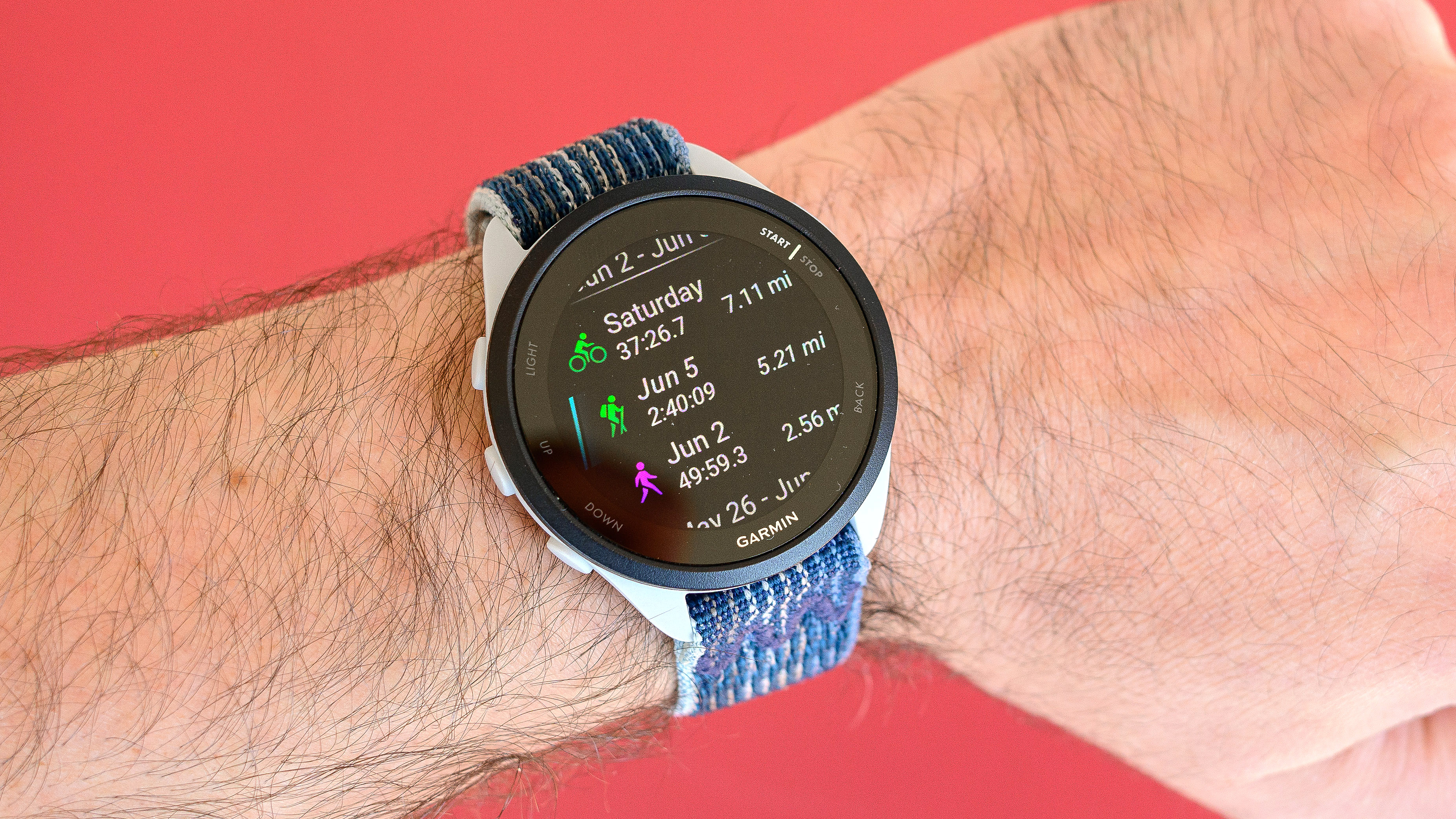
The Garmin Forerunner 165 does not track multisport activities, like triathlons. For that functionality, you'll need to step up to the Forerunner 265.
Similarly, it doesn't have support for nearly as many sports profiles as its older sibling. By the numbers, the Forerunner 165 tracks 25 workout types while the Forerunner 265 tracks 55+ including a wide range of team and extreme sports not offered on the 165.
Still, the Forerunner 165 has popular workouts covered, including strength training, HIIT, cardio, running, walking, hiking, biking, trail running and swimming. You also get support for yoga, Pilates, tennis, and, of course, pickleball. However, if you want to track your next snowboard mission or cricket match, the Forerunner 265 is a better bet.
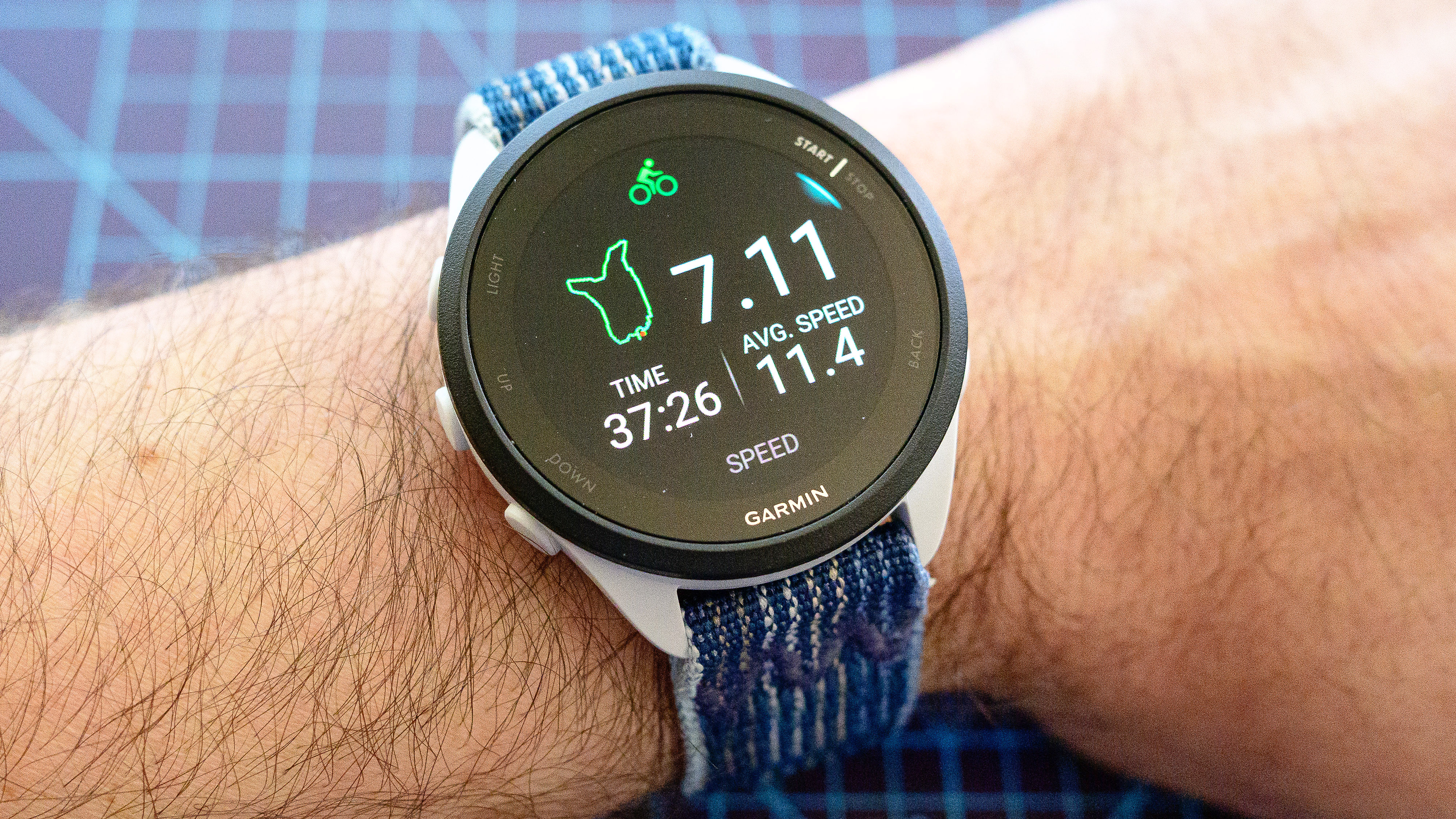
Garmin Forerunner 165 review: health and sleep tracking
To keep tabs on health and fitness, the Forerunner 165 sports an optical heart rate sensor and pulse oximeter (SpO2 sensor). However, for on-wrist ECGs (Electrocardiogram), you'll need to step up to the Garmin Epix Pro, Fenix 7 Pro or Venu 3.
The aforementioned sensors additionally monitor your quality of rest while sleeping. In the A.M., the Forerunner 165 provides a daily Morning Report with details on how well you slept and what your training outlook is for the day. Sleep insights come in the form of a sleep score and also include details about your various sleep stages, namely, REM.
The Morning Report additionally includes a weather bulletin and details on the previous night's heart rate variability (HRV). This metric can help inform how ready you are to take on the day by measuring changes in rhythm between heartbeats. Finally, the 165 has nap detection for daytime snoozes.
Like most of Garmin's modern fitness trackers, the Forerunner 165 also supports women’s health monitoring for menstrual cycle and pregnancy tracking.
Garmin Forerunner 165 review: training and recovery features
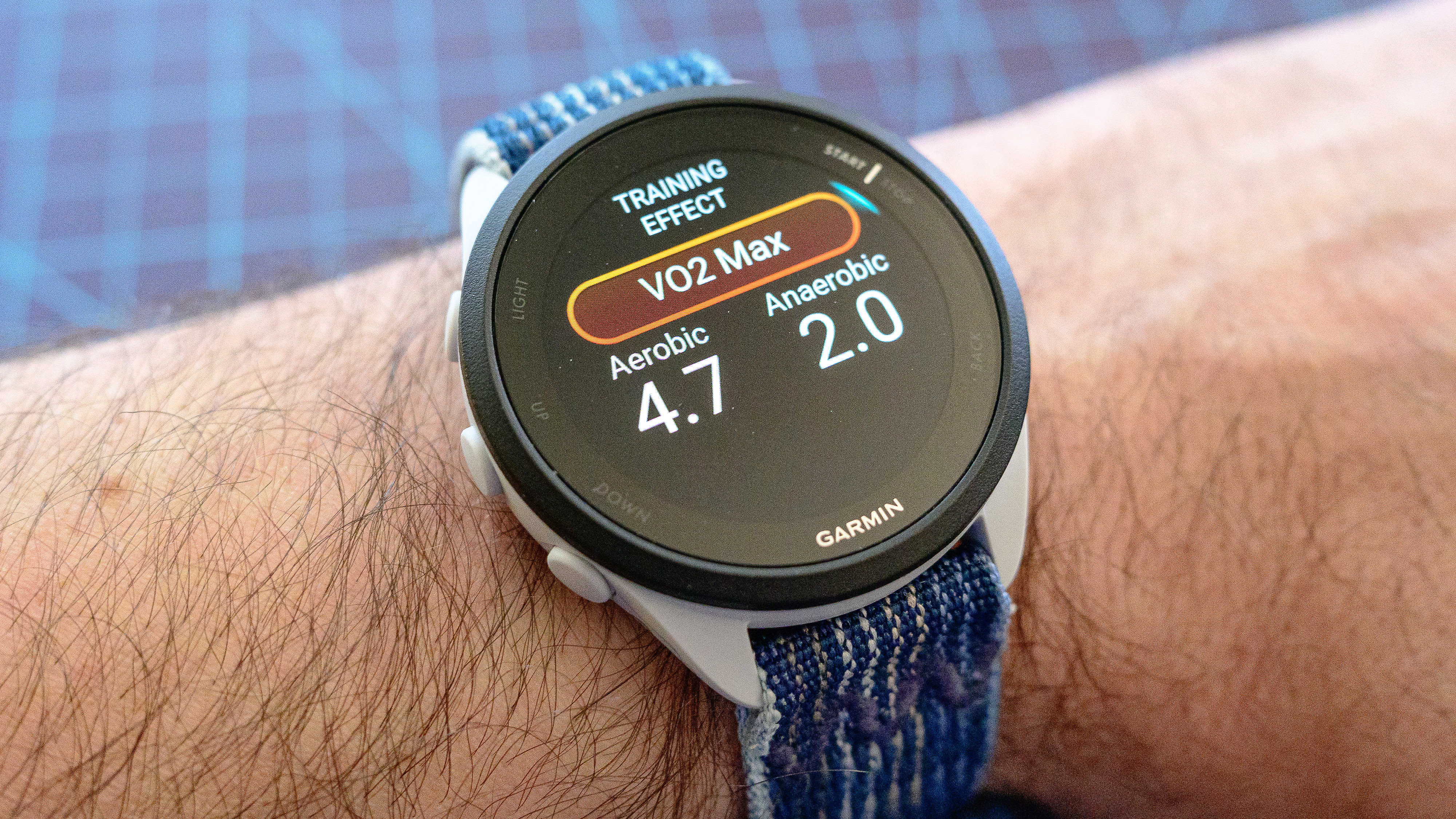
Many of Garmin's best training tools have trickled down from more advanced models to the Garmin Forerunner 165, including daily workout suggestions, completion time predictions for upcoming races and Garmin's Body Battery feature, which keeps tabs on overall energy levels and suggests the best times of day to workout.
The device also tells you an estimated recovery time, post-workout. For instance, after a particularly strenuous activity, it may recommend you lay low for up to several days. This was the Forerunner 165's recommendation after I recently knocked a hike with a lot of elevation gain over a short amount of mileage.
Training Effect is another useful tool that can help you better understand your progress toward fitness goals. Similarly, the V02 Max score is a great way to better comprehend your body's performance capacity, especially when doing high-cardio activities.
For runners — particularly, the marathon-loving masses — the Garmin Forerunner 165 features adaptive training plans to help folks prepare for events. It can also analyze your running dynamic to help improve form, tracking cadence, stride length and ground contact time.
Other features for runners include adaptive training plans via the Garmin Coach tool. You also get Pace Pro, which uses your GPS location to help keep you on pace for compatibility courses/routes. Presently, Pace Pro is only available for running routes but I'm hopeful Garmin will add support for cycling as well.
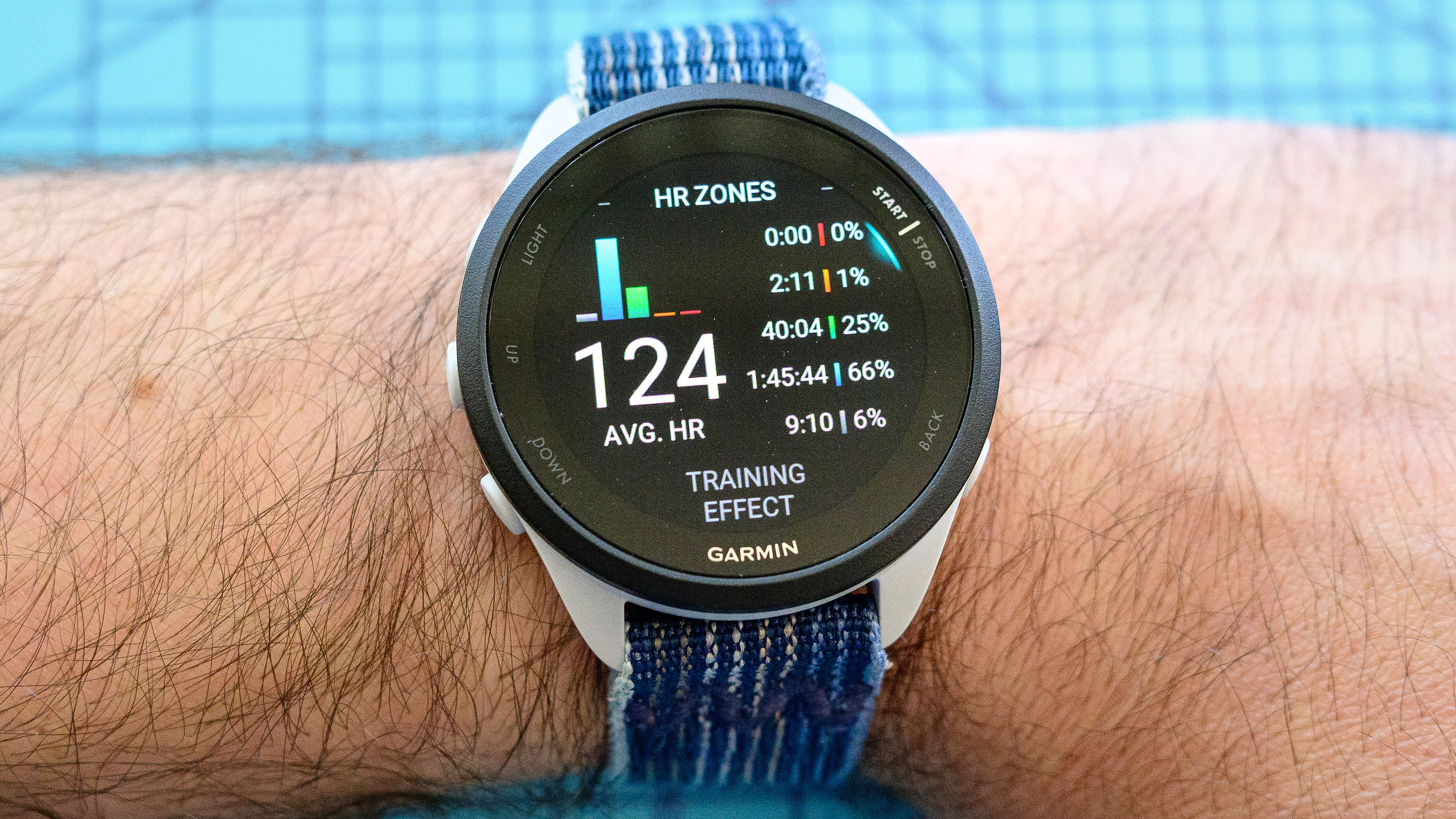
Garmin Forerunner 165 review: smart and safety features
Both versions of the Garmin Forerunner 165 offer the same fairly basic smart features — music storage on the 165 Music, aside —including support for smartphone notifications from a connected device, Garmin Pay, and the ability to download additional apps from the Garmin Connect I.Q. store where you'll also find some fresh watch faces.
The Garmin Forerunner 165 Music works nicely with Spotify, Amazon Music, Deezer and YouTube Music. If you have a paid account on any of these services, you can download tunes to 165 Music for offline listening. You get 4GB of storage, which should be good for about 500 songs.
For safety, the Forerunner 165 has LiveTrack, which lets you share your up-to-date GPS location with loved ones while out on an adventure. An Incident Decetion feature can also be set up to alert an emergency contact or responders if a drastic change in movement is recorded by the watch, i.e. a fall. When this happens, users will have a 30-second window to cancel the alert if it's a false alarm.
Garmin Forerunner 165 review: battery life

Garmin says that battery life on the Forerunner 165 should be good for 11 days in standard smartwatch mode and up to 19 hours when using the GPS to track activities.
In reality, you can expect roughly a week of juice when using a mix of the two. I tend to work out four to five days a week for roughly 40 minutes a session while wearing the device at night. Under these circumstances, I'm topping it off every five to seven days.
Speaking of which, it charges via a proprietary cable that plugs into the back of the watch and a standard USB-C port. A full charge should take just under two hours.
Should you buy the Garmin Forerunner 165?
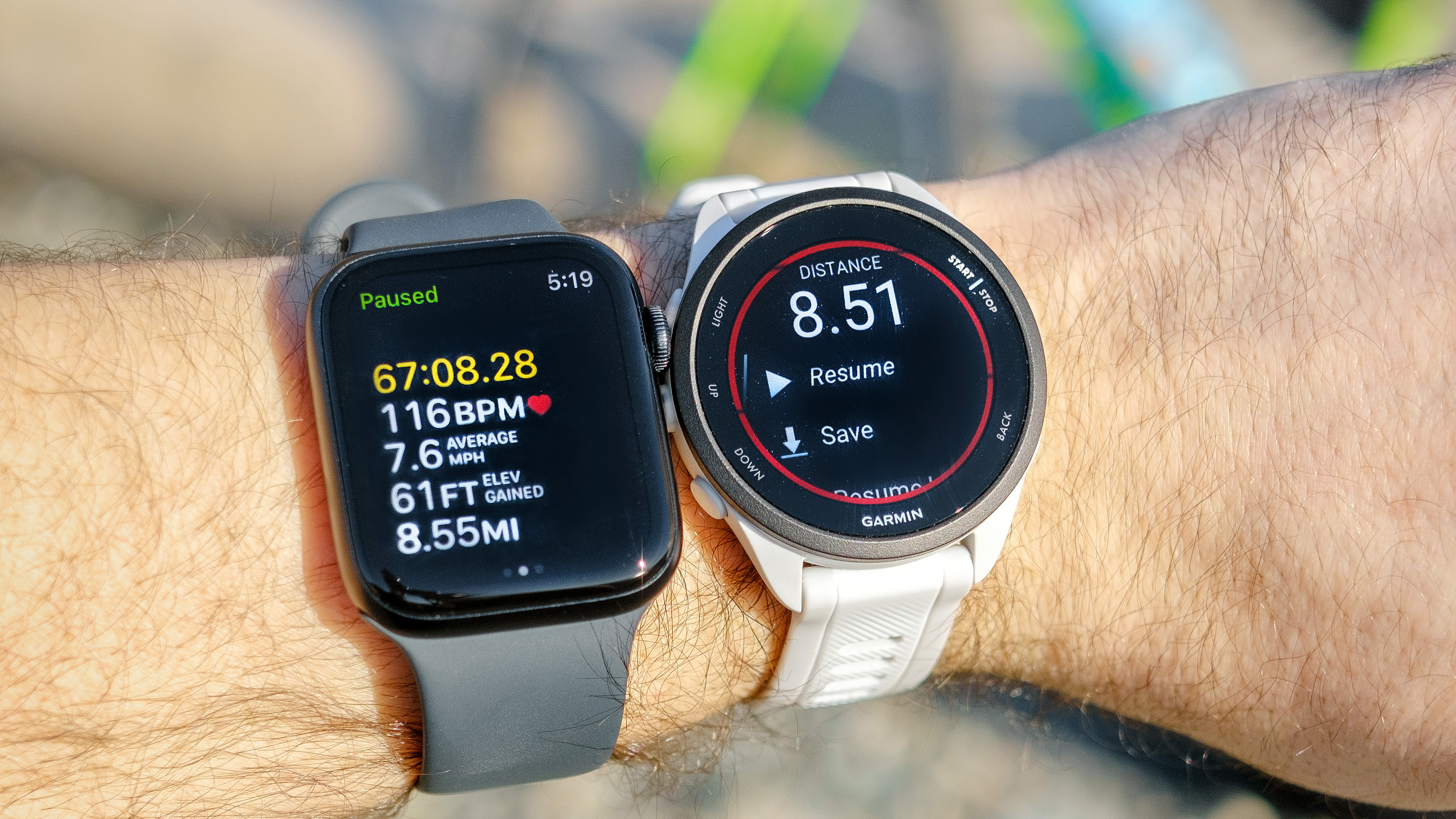
The Garmin Forerunner 165 is easily one of my favorite GPS smartwatches because it's unbothersome to wear and tracks the basics with solid reliability. Even though many of the standout training and recovery tools are marketed toward runners, the device also has a lot to offer for folks who like to walk, hike or bike outdoors.
The Forerunner 165 also has respectable battery life whether using the GPS or not, is easy to operate when sweaty thanks to physical buttons around the bezel and feels great on the wrist. Plus, the bright and vibrant AMOLED touchscreen sets it apart from the entry-level Forerunner 55 in a meaningful way.
However, it lacks the more advanced activity-tracking profiles found on the Forerunner 265 — like those for skiing, ultimate frisbee, MMA, inline skating, badminton, etc — and dual-band GPS. The latter isn't necessarily a deal-breaker, though, if you don't mind waiting up to a minute for a GPS signal at the start of a workout.
For those who want basic workout, sleep and activity tracking coupled with true smartwatch features, the Apple Watch SE may be a better choice for the cash. But, for some of the best training and recovery tools in the biz in a lovely and capable little package, and at a solid price, the Garmin Forerunner 165 is a winner.

Dan Bracaglia is the Tom’s Guide editorial lead for all things smartwatches, fitness trackers and outdoor gear. With 15 years of experience as a consumer technology journalist testing everything from Oura Rings to instant cameras, Dan is deeply passionate about helping readers save money and make informed purchasing decisions. In the past year alone, Dan has assessed major product releases from the likes of Apple, Garmin, Google, Samsung, Polar and many others.
An avid outdoor adventurer, Dan is based in the U.S. Pacific Northwest where he takes advantage of the beautiful surroundings every chance he gets. A lover of kayaking, hiking, swimming, biking, snowboarding and exploring, he also makes every effort to combine his day job with his passions. When not assessing the sleep tracking and heart rate accuracy of the latest tach gadgets, you can find him photographing Seattle’s vibrant underground music community.
